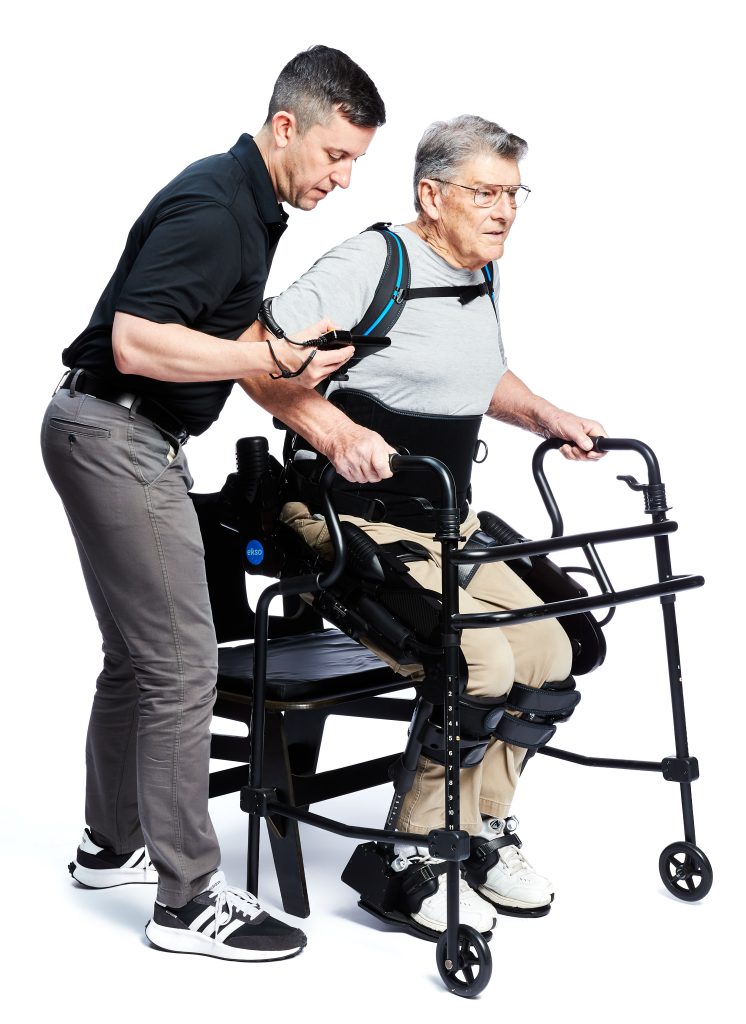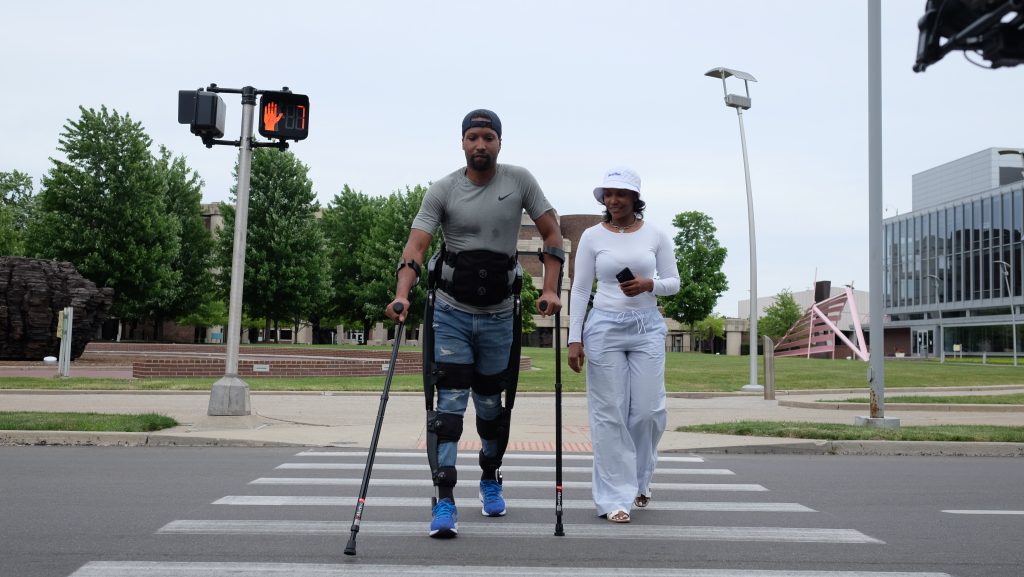Spinal cord injuries (SCI) can be life-altering, often resulting in limited mobility and loss of independence. For individuals with SCI, rehabilitation is crucial to regain as much function as possible. One groundbreaking technology that is helping many in their recovery journey is the use of exoskeletons. These wearable devices, once the stuff of science fiction, are now playing a significant role in both hospital and home settings. They offer new hope for people with SCI by helping them walk again, enhancing mobility, and improving overall health outcomes.
In this blog, we’ll explore how exoskeletons are used from the hospital to home. We’ll also discuss some of the concerns potential exoskeleton users have, including Medicare coverage and insurance coverage for an exoskeleton.
What is an Exoskeleton?
An exoskeleton is a powered wearable device designed to assist human movement, particularly for those who have experienced a mobility impairment, such as from a spinal cord injury or stroke. Historically, these devices have only been used in rehabilitation, and this is still where you are most likely to use one. Some models are now also available for home and community use.
Exoskeletons for people with SCI are controlled in different ways to allow and support walking. Using an exoskeleton also allows people who typically use a wheelchair to stand up. This provides health improvements like maintaining range of motion, decreasing spasticity, preventing muscle atrophy, improving cardiovascular health, and aiding with bowel and bladder voiding. Some exoskeletons like Ekso Indego are controlled through postural positions, so a user does not have to have any strength in their legs to be able to walk. The motors can also decrease how much assistance they provide, if the user is able to contribute partially to the movement using their own strength.
By supporting the user’s weight and guiding their legs through walking motions, an exoskeleton can help the individual regain a sense of independence, retrain their muscles, and, in some cases, even improve their long-term mobility enough to have them “walk out” of the exoskeleton.
Using an Exoskeleton in a Hospital Setting
After experiencing an SCI, a person will first be transported to an acute care hospital to become medically stabilized. Once they are ready for more intensive rehabilitation, a physical therapist typically determines if a patient with SCI is a good candidate for exoskeleton therapy, like EksoNR. This decision is based on factors including the patient’s weight, therapy goals, and other health concerns. Once a patient is deemed appropriate for exoskeleton therapy by their physician and care team, they will undergo a formal evaluation and measurements to assure that the technology is right for them.
The EksoNR exoskeleton provides advantages to those early in their rehabilitation, making it the perfect tool to utilize during this hospital-based stage. It supports the user through the trunk, allowing those with poor trunk control to stand up and walk, even though they may struggle to sit at the edge of the bed. EksoNR can provide full assistance to those who are weak but can also take assistance away as the patient gets stronger. EksoNR provides support through the legs preventing buckling, which could cause a fall. This allows the therapist the ability to focus on the quality of gait instead of just focusing on safety. All these features allow EksoNR to be used as early as possible in rehabilitation, which is critical for recovery. Sessions in EksoNR may focus on balance, pre-gait activities, walking, or strengthening.

EksoNR also allows the therapist to create the most perfect stepping pattern for each patient. Learning how to walk correctly can help to reduce complications later including pain and decreased endurance. The goal of using a robotic exoskeleton in rehabilitation may be to help the patient relearn how to walk so that they can leave the hospital on foot, or it might be to help the patient master skills such as weight shifting which will allow them to be as independent as possible with transfers and daily activities.
The feedback provided by EksoNR can help therapists ensure that patient’s progress is closely monitored, and adjustments are made as needed. It also allows therapists to make sure they are appropriately challenging the patient.
Using an Exoskeleton in the Outpatient Setting
Once a patient is discharged home from the rehabilitation hospital, they likely will continue to receive therapy through an outpatient facility. Patients may continue to use a rehab exoskeleton in this setting to fine-tune their gait, continue strengthening, and gain more independence.
The Ekso Indego Therapy exoskeleton is one option of a robotic exoskeleton that may be used in this setting. Ekso Indego is lighter and supports only through the hips, making it feel less restrictive. It knows when to take a step based on postural position, and it is very easy to learn.

Ekso Indego can be used by any trained healthcare professional for patients with multiple goals. Similar to EksoNR, assistance provided by the device can be adjusted to challenge the patient who is regaining strength in their legs. For those with SCI who may need an exoskeleton at home long-term, using it in therapy can be a great start to learning the device and seeing if it is right for you. You can also get a sense for if the device will help you meet your specific goals for the home and community.
Advantages of Rehabilitation Use – Inpatient and Outpatient
Using an exoskeleton under the guidance of a healthcare professional offers several benefits:
-
- Medical Supervision: Therapists can offer real-time feedback and make necessary adjustments to the device.
- Safety: Controlled environments ensure patient safety, minimizing the risk of falls or injuries.
- Team-Based Approach: A coordinated team of doctors, therapists, and technicians work together to create the best possible rehabilitation plan.
- Early use: Soon after an injury is the perfect time to capitalize on rehabilitation as the body is primed to learn.
By combining exoskeleton therapy with other forms of physical rehabilitation, patients may see faster results and make significant strides in their recovery.
Transitioning to Home Use of an Exoskeleton
For those who are eligible, having an exoskeleton for use at home is now an option. Eligibility is based off a number of factors including health status, level of injury, and body size. This device would not replace a wheelchair but would allow users to stand and walk in their home and community with the supervision of a support person. This support person can be anyone: a spouse, parent, child, or caregiver who will receive device training with the user.
The Ekso Indego Personal exoskeleton is the perfect device for home and community use because it is modular and lightweight. It breaks down into 5 separate pieces which can be placed in a duffle bag, making it easy to bring from place to place. It also can be worn by a passenger in a car.

Home exoskeleton devices like Ekso Indego Personal can also walk on different surfaces and inclines. They can be used anywhere a wheelchair could. Having a personal exoskeleton for home provides the user both physical and mental health benefits. Simple tasks like washing dishes or looking in the mirror while brushing your teeth are more challenging or impossible from a sitting position. Ekso Indego Personal allows the user to complete chores and activities like these from standing.
Both the patient and their support person will undergo training to ensure safe and effective use of the exoskeleton at home. This training covers how to properly wear and control the device, navigate various terrains, and use it in different daily activities.
While the exoskeleton can’t replace all mobility aids, it can complement the use of a wheelchair by providing an option for standing and walking.
Advantages of Home Use
-
- Increased Independence: The exoskeleton provides the ability to move in ways that would otherwise be impossible, increasing the patient’s independence.
- Health Benefits: Regular movement with an exoskeleton can improve cardiovascular health, strengthen muscles, and prevent complications like pressure sores.
- Improved Mental Health: Regaining mobility, even partially, can significantly boost mental well-being and confidence.
Cost Considerations
One of the biggest challenges for individuals seeking to use an exoskeleton for home and community use is the cost. Exoskeletons are sophisticated pieces of technology, and this comes with a high price tag. Veterans and persons who are covered under workers compensation insurance are eligible to receive a personal exoskeleton at little to no cost. Medicare coverage for personal exoskeletons like Ekso Indego Personal may be available for eligible beneficiaries. We expect other insurances to follow suit in the future, providing insurance coverage for this life-changing technology. The team at Ekso Bionics can help determine if insurance may cover all or part of the cost for any interested individual.